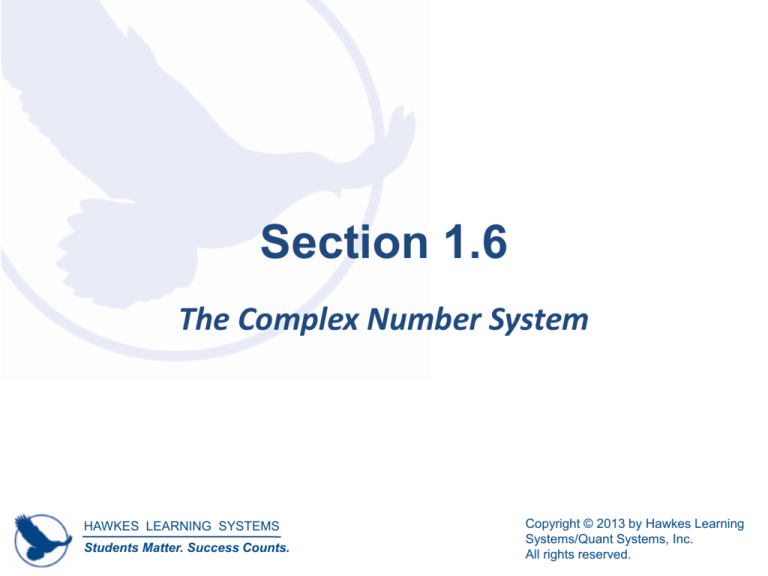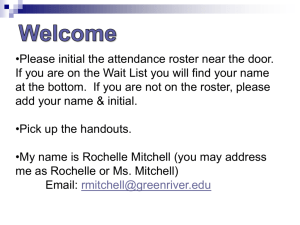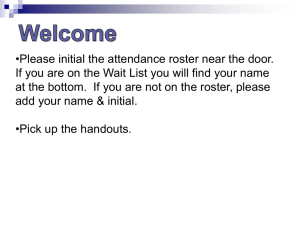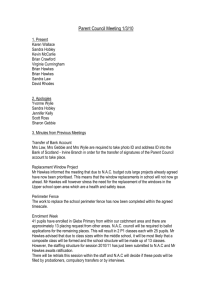
Section 1.6
The Complex Number System
HAWKES LEARNING SYSTEMS
Students Matter. Success Counts.
Copyright © 2013 by Hawkes Learning
Systems/Quant Systems, Inc.
All rights reserved.
Topics
o The imaginary unit i and its properties
o The algebra of complex numbers
o Roots and complex numbers
HAWKES LEARNING SYSTEMS
Students Matter. Success Counts.
Copyright © 2013 by Hawkes Learning
Systems/Quant Systems, Inc.
All rights reserved.
The Imaginary Unit i and its Properties
The Imaginary Unit i
The imaginary unit i is defined as i 1. In other
2
i
words, i has the property that its square is −1: 1.
HAWKES LEARNING SYSTEMS
Students Matter. Success Counts.
Copyright © 2013 by Hawkes Learning
Systems/Quant Systems, Inc.
All rights reserved.
The Imaginary Unit i and its Properties
Square Roots of Negative Numbers
If a is a positive real number, a i a . Note that by
this definition, and by a logical extension of
2
2
2
exponentiation, i a i
a a.
HAWKES LEARNING SYSTEMS
Students Matter. Success Counts.
Copyright © 2013 by Hawkes Learning
Systems/Quant Systems, Inc.
All rights reserved.
Example 1
a.
b.
16 i 16 i 4 4i.
As is customary, we write a constant such as 4
before letters in algebraic expressions, even if, as in
this case, the letter is not a variable. Remember that
i has a fixed meaning: i is the square root of −1.
8 i 8 i 2 2 2i 2.
As is customary, again, we write the
radical factor
2
last. You should verify that 2i 2 is indeed −8.
HAWKES LEARNING SYSTEMS
Students Matter. Success Counts.
Copyright © 2013 by Hawkes Learning
Systems/Quant Systems, Inc.
All rights reserved.
Example 1 (cont.)
4
2 2
and
i i i 1 1 1.
c. i i i 1 i i ,
The simple fact that i2 = −1 allows us, by our
extension of exponentiation, to determine in for any
natural number n.
3
2
d. i 1 i i 2 1.
2
2 2
This observation shows that −i also has the property
that its square is −1.
HAWKES LEARNING SYSTEMS
Students Matter. Success Counts.
Copyright © 2013 by Hawkes Learning
Systems/Quant Systems, Inc.
All rights reserved.
The Imaginary Unit i and its Properties
Complex Numbers
For any two real numbers a and b, the sum a + bi is a
complex number. The collection = {a + bi|a and b are
both real} is called the set of complex numbers and is
another example of a field. The number a is called the
real part of a + bi, and the number b is called the
imaginary part. If the imaginary part of a given
complex number is 0, the number is simply a real
number. If the real part of a given complex number is 0,
the number is a pure imaginary number.
HAWKES LEARNING SYSTEMS
Students Matter. Success Counts.
Copyright © 2013 by Hawkes Learning
Systems/Quant Systems, Inc.
All rights reserved.
The Algebra of Complex Numbers
Simplifying Complex Expressions
Step 1: Add, subtract, or multiply the complex
numbers, as required, by treating every
complex number a + bi as a polynomial
expression. Remember, though, that i is not
actually a variable. Treating a + bi as a binomial
in i is just a handy device.
Step 2: Complete the simplification by using the fact
that i2 = −1.
HAWKES LEARNING SYSTEMS
Students Matter. Success Counts.
Copyright © 2013 by Hawkes Learning
Systems/Quant Systems, Inc.
All rights reserved.
Example 2
Simplify the following complex number expressions.
a. 4 3i 5 7i
b. 2 3i 3 3i
c. 3 2i 2 3i
d. 2 3i
2
Solutions:
a. 4 3i 5 7i
4 5 3 7 i
1 10i
HAWKES LEARNING SYSTEMS
Students Matter. Success Counts.
Treating the two complex numbers
as polynomials in i, we combine
the real parts and then the
imaginary parts.
Copyright © 2013 by Hawkes Learning
Systems/Quant Systems, Inc.
All rights reserved.
Example 2 (cont.)
b. 2 3i 3 3i
2 3i 3 3i
We begin by distributing the
minus sign over the two terms
of the second complex number,
and then combine as in part a.
2 3 3 3 i
1 0i
1
HAWKES LEARNING SYSTEMS
Students Matter. Success Counts.
Copyright © 2013 by Hawkes Learning
Systems/Quant Systems, Inc.
All rights reserved.
Example 2 (cont.)
c. 3 2i 2 3i
6 9i 4i 6i 2
6 9 4 i 6 1
The product of two complex numbers
leads to four products via the
distributive property, as illustrated
here. After multiplying, we combine
the two terms containing i, and
rewrite i2 as −1.
6 5i 6
12 5i
HAWKES LEARNING SYSTEMS
Students Matter. Success Counts.
Copyright © 2013 by Hawkes Learning
Systems/Quant Systems, Inc.
All rights reserved.
Example 2 (cont.)
d. 2 3i 2 3i 2 3i
2
4 6i 6i 9i 2
4 12i 9 1
Squaring this complex number
also leads to four products,
which we simplify as in part c.
Remember that a complex
number is not simplified until it
has the form a + bi.
5 12i
HAWKES LEARNING SYSTEMS
Students Matter. Success Counts.
Copyright © 2013 by Hawkes Learning
Systems/Quant Systems, Inc.
All rights reserved.
Example 3
Simplify the quotients.
2 3i
a.
3i
b. 4 3i
1
1
c.
i
HAWKES LEARNING SYSTEMS
Students Matter. Success Counts.
Copyright © 2013 by Hawkes Learning
Systems/Quant Systems, Inc.
All rights reserved.
Example 3(cont.)
Solutions:
2 3i 2 3i 3 i
a.
3i
3 i
3i
2 3i 3 i
3 i 3 i
6 2i 9i 3i 2
9 3i 3i i 2
3 11i
3 11
i
10
10 10
HAWKES LEARNING SYSTEMS
Students Matter. Success Counts.
We multiply the top and bottom
of the fraction by 3 + i, which is
the complex conjugate of the
denominator. The rest of the
simplification involves multiplying
complex numbers as in the last
example.
We would often leave the answer
3 11i
in the form
unless it is
10
necessary to identify the real and
imaginary parts.
Copyright © 2013 by Hawkes Learning
Systems/Quant Systems, Inc.
All rights reserved.
Example 3(cont.)
b. 4 3i
1
1
4 3i
1 4 3i
4 3i 4 3i
4 3i
4 3i 4 3i
In this example, we simplify
the reciprocal of the complex
number 4 − 3i. After writing
the original expression as a
fraction, we multiply the top
and bottom by the complex
conjugate of the denominator
and proceed as in part a.
4 3i
16 9i 2
4 3i
4 3
i
25
25 25
HAWKES LEARNING SYSTEMS
Students Matter. Success Counts.
Copyright © 2013 by Hawkes Learning
Systems/Quant Systems, Inc.
All rights reserved.
Example 3(cont.)
1 1 i
c.
i i
i
i
2
i
This problem illustrates the process of
writing the reciprocal of the
imaginary unit as a complex number.
Note that with this as a starting point,
we could now calculate i –2, i –3, …
i
1
i
HAWKES LEARNING SYSTEMS
Students Matter. Success Counts.
Copyright © 2013 by Hawkes Learning
Systems/Quant Systems, Inc.
All rights reserved.
Example 4
Simplify the following expressions.
a. 2 3
b.
2
4
4
HAWKES LEARNING SYSTEMS
Students Matter. Success Counts.
Copyright © 2013 by Hawkes Learning
Systems/Quant Systems, Inc.
All rights reserved.
Example 4 (cont.)
Solutions:
2
a. 2 3 2 3 2 3
4 4 3 3 3
4 4i 3 i 3
4 4i 3 3
2
Each 3 is converted
to i 3 before carrying
out the associated
multiplications. Note that
incorrect use of one of the
properties of radicals
would have led to adding 3
instead of subtracting 3.
1 4i 3
HAWKES LEARNING SYSTEMS
Students Matter. Success Counts.
Copyright © 2013 by Hawkes Learning
Systems/Quant Systems, Inc.
All rights reserved.
Example 4 (cont.)
b.
4
2
4 2i
1
i
i
1
We have already simplified
in Example 3c, so
i
we quickly obtain the correct answer of −i. If we
had incorrectly rewritten the original fraction as
4
, we would have obtained 1 or i as the
4
final answer.
HAWKES LEARNING SYSTEMS
Students Matter. Success Counts.
Copyright © 2013 by Hawkes Learning
Systems/Quant Systems, Inc.
All rights reserved.




